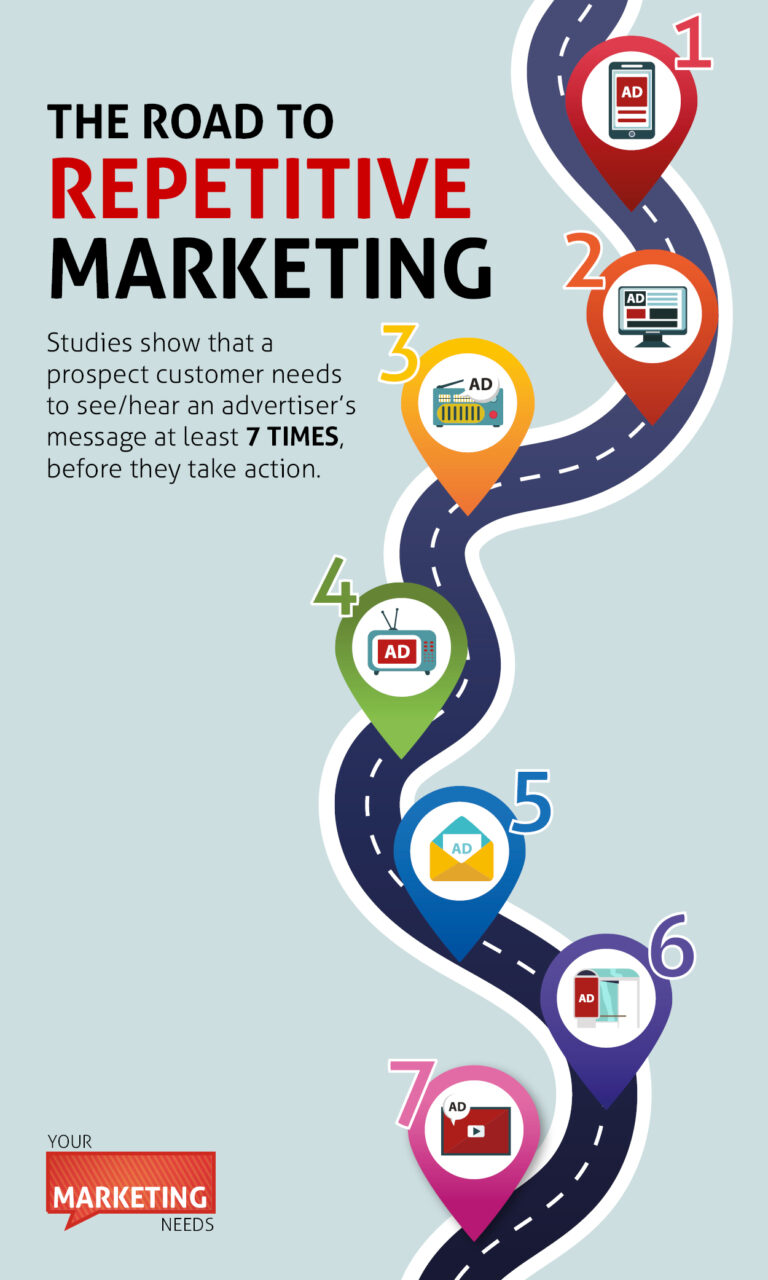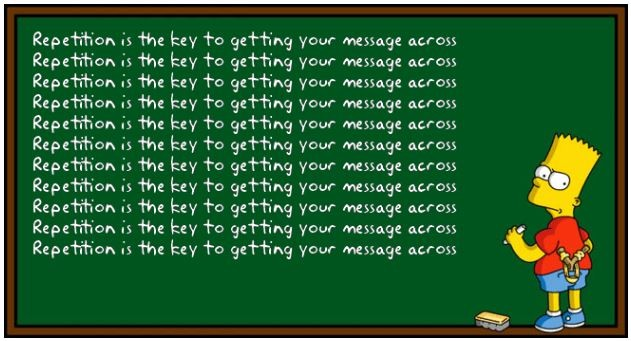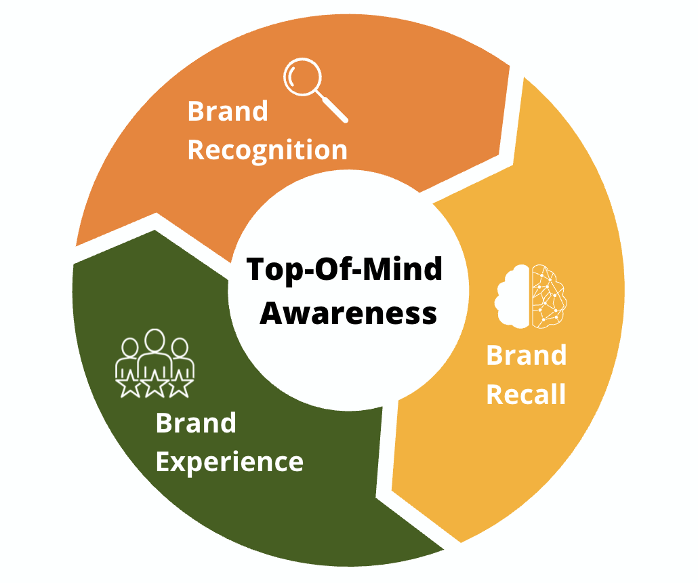Repetition in Advertising: Why We Keep Repeating the Same Things
Some of our team members here at Single Grain periodically get asked why we repeat ourselves so much. It’s definitely not because we’re lazy or have run out of ideas. Our repetition is calculated and deliberately cadenced to remind people of what matters most when it comes to digital marketing.
Why does that work, you ask?
In this blog post, we’ll explore the significance of repetition in advertising and its effectiveness in capturing consumer attention over long stretches of time.
TABLE OF CONTENTS:
The Role of Repetition in Advertising
One fundamental reason why repetition is employed in advertising is focus. Many highly successful entrepreneurs, including Warren Buffett and Bill Gates, attribute their achievements to unwavering focus.
We’ve talked about the rule of seven before in previous posts: It’s important to remember that people often need multiple exposures to a message before they take action.
By repeatedly emphasizing specific messages or ideas, advertisers guide consumers toward what truly matters:

Despite hearing incredible advice, we tend to implement it far less frequently than we think. Repetition bridges this gap by encouraging action and directing attention toward the most critical aspects.
The Science Behind Repetition in Advertising
Repetition in advertising is not a mere shot in the dark or a haphazard tactic. Instead, it is rooted in scientific principles that govern human cognition and perception. One such principle that underpins the effectiveness of repetition is the mere exposure effect — a cognitive bias ingrained in our brains.
The mere exposure effect posits that individuals tend to develop a preference for things they encounter more frequently.
In other words, the more we are exposed to a stimulus, the more familiar and comfortable it becomes, leading to a positive bias toward it. Advertisers leverage this psychological phenomenon to their advantage by strategically repeating their brand messages, visuals and other marketing elements.
This familiarity breeds a sense of trust and confidence in consumers, as they subconsciously associate repetition with importance and reliability.
Over time, this repeated exposure strengthens positive associations with the brand, leading to increased brand affinity and customer loyalty.
Think about it. Have you ever found yourself automatically gravitating towards a brand simply because you’ve seen its ads or heard its jingle countless times? That’s the mere exposure effect in action. By consistently presenting their messaging to consumers, advertisers are essentially priming their target audience to develop a favorable perception of their brand.
Repetition also plays a vital role in establishing top-of-mind awareness. When consumers encounter a problem or a need that aligns with a particular product or service, they are more likely to recall and consider brands that have been consistently present in their consciousness through repetitive advertising.
This recall is a direct result of the cognitive bias formed by the mere exposure effect.
Effective Strategies for Repetitive Advertising
While repetition is vital, it’s equally important to execute it effectively. Simply regurgitating information without purpose or strategy won’t yield the desired results.
Here are a few techniques that demonstrate how repetition can be leveraged intelligently:
- Creating Brand Recall through Advertising Repetition: Consistently repeating key elements such as slogans, jingles or visual cues strengthens brand recall. By integrating these elements into various marketing channels, businesses can establish a lasting impression in consumers’ minds.
- Repetitive Advertising Techniques: Employing diverse forms of media, including TV, radio, social media and print allows marketers to repeat their message across multiple platforms. This multi-channel approach enhances the chances of reaching a broader audience and reinforces the brand’s presence.
- The Psychological Impact of Advertising Repetition: Repetition taps into the psychology of familiarity and cognitive biases. When people encounter familiar messages repeatedly, they subconsciously perceive them as more trustworthy and reliable, influencing their purchase decisions.
Related Content: 6 Proven Advertising Strategies for Online Success
How Repetition Influences Consumer Behavior
One of the primary effects of repetition is the establishment of familiarity. When a message is repeatedly presented to consumers, it becomes ingrained in their minds, creating a sense of familiarity with the brand.
This familiarity plays a crucial role in influencing consumer behavior because people tend to feel more comfortable and trusting towards things they are familiar with. In a crowded marketplace, where consumers are bombarded with numerous choices, the familiar brand stands out and gains an advantage. Consumers are more likely to choose a brand they recognize and feel familiar with over an unfamiliar one:

Furthermore, repetition helps build trust and credibility. Repetition conveys the idea that the brand is confident in its message and believes in its value proposition. As a result, consumers are more inclined to trust and have confidence in the brand, as they perceive it to be more credible and trustworthy.
Repetition also plays a crucial role in influencing consumer perceptions. When a message is repeated consistently, it becomes associated with certain qualities, values or benefits. For example, if a brand consistently emphasizes its commitment to sustainability through repetitive messaging, consumers are more likely to perceive the brand as environmentally conscious and trustworthy in that domain.
In addition, repetition acts as a reinforcement mechanism. It helps to reinforce key information, benefits or unique selling propositions in consumers’ minds. When faced with choices, consumers are more likely to recall and consider brands that have consistently reinforced their message through repetition.
In a broader sense, repetition creates a psychological impact by making a brand more salient in consumers’ minds.
Ultimately, the influence of repetition on consumer behavior can be seen in the purchasing choices consumers make. The familiarity, trust, credibility and positive associations formed through repetition significantly impact consumers’ decision-making processes.
Related Content: Neuromarketing 101: How Neuroscience Affects Customers’ Buying Behaviors
Measuring the Effectiveness of Repetitive Advertising Campaigns
When it comes to repetitive advertising campaigns, evaluating their effectiveness is crucial for marketers to understand the impact of their efforts and make informed decisions for future strategies.
Brand Recognition
One essential metric to consider is brand recognition:

Repetition plays a vital role in establishing brand familiarity and recognition among consumers.
Measuring brand recognition involves assessing the level of awareness and familiarity consumers have with the brand. Surveys, focus groups and brand recall tests can be conducted to gauge the extent to which consumers recognize the brand and its associated messaging.
Tracking changes in brand recognition over time provides insights into the effectiveness of repetitive advertising in increasing brand awareness and visibility.
Brand Recall
Another significant metric in measuring the effectiveness of repetitive advertising campaigns is brand recall:

How capable is your audience of remembering your brand’s offer? It’s no secret that brands want to permeate the minds of their target audiences in order to thrive. Repeat marketing can be a central mechanism that promotes brand recall in your audience.
Techniques such as aided and unaided recall tests can be employed to measure the recall rates among target audiences. High recall rates indicate that the repetitive advertising efforts have successfully imprinted the brand and its messages in the minds of consumers.
Brand Engagement
Engagement levels are also crucial indicators of the effectiveness of repetitive advertising campaigns. The best key metrics you ought to be looking at when it comes to measuring your audience engagement in response to your ads is:
- Click-through rates
- Website traffic
- Social media interactions (shares, comments, likes, follows)
- Time-on-site
- Bounce rates
- Conversion actions
Higher engagement levels suggest that the repetitive advertising is resonating with the target audience and driving them to interact with the brand.
Related Content: 7 Mistakes in UI and UX That Are Costing You Engagement
Final Thoughts on Our Repetition in Advertising
Well, there you have it. Our full alibi as to why we are constantly repeating ourselves (plus some pointers!).
The trick is riding the balance of being sufficiently repetitious without being obnoxious to your audience. When you present the same ideas over and over, you’ll be constantly sharing the word about your expertise to people all throughout the buyer’s journey.
Whether they’re in the early awareness stage, the exploration and information-gathering stage, or the decision-making stage, all moments warrant hearing your messaging as a gentle reminder that you exist, that you know what you’re talking about, and that you’re ready to help.
So the next time you’re asking yourself if you’re being redundant, instead, think about all of the people that haven’t yet heard your message.
So go forth, and repeat yourself!
Repurposed from our Marketing School podcast.
Repetition in Advertising FAQ
-
How effective is repetition in advertising for boosting brand recall?
Repetition in advertising is highly effective at boosting brand recall. Repeated exposures trigger the mere exposure effect (a cognitive bias where familiarity breeds trust) and keep your brand more salient at buying moments. Use creative consistency: same tagline, visual identity, and sonic cues across channels. That primes memory and strengthens aided and unaided recall over time. Think about it: the message you see most often is the one you remember when it counts.
-
Does repetition in advertising work, or does it just annoy people?
Yes, repetition in advertising works when you pace it and keep it useful. Familiarity bias builds trust, but hammering the same ad invites fatigue. Rotate formats while repeating the core cue (tagline, jingle, visual hook). Watch engagement metrics: rising CTR and time-on-site suggest you’re on track; spikes in mutes, hides, or skips mean ease off. The trick is riding the balance so your message stays welcome, not wearisome.
-
What is the rule of seven, and how does it relate to advertising repetition effectiveness?
The rule of seven says people often need multiple touches before they act, which underpins advertising repetition effectiveness. Those exposures prime memory, increase salience, and create top-of-mind awareness. It’s a guide, not a law. Calibrate by channel and audience, then verify with aided/unaided recall studies and lift tests alongside engagement trends. We’ve talked about the rule of seven before—use it as a starting line, not the finish.
-
How does repetition in ads leverage the mere exposure effect to increase brand recognition?
Repetition in ads taps the mere exposure effect to boost brand recognition. Each consistent impression—logo, colors, sonic logo, tagline—primes the brain, lowering cognitive load the next time we see you. That familiarity bias nudges attention and improves both aided and unaided recall. Have you ever found yourself humming a jingle uninvited? That’s the principle quietly doing its job.
-
What repetitive advertising techniques actually improve brand recall across channels?
The most effective repetitive advertising techniques repeat the signal, not the ad. Keep your core message, slogan, and visual identity identical, but rotate creative executions and media placements. Mix short video, static, audio, and UGC while anchoring to the same brand cue. This multi-channel cadence builds priming and salience without boredom, leading to stronger brand recall and smoother conversion paths.
-
What message frequency for repetition in advertising supports brand recall without ad fatigue?
For message frequency in repetition in advertising, start modestly, cap frequency, and watch reactions. Use the rule of seven as a mental model, then tune by channel. Rotate creative while repeating the same mnemonic (tagline, jingle, color system). If recall lifts and engagement rises, you’re close; if skips, hides, and bounce rates climb, you’re overdoing it. Think about it: welcomed beats wall-to-wall.
-
How do you measure the effectiveness of repetition in advertising?
Measure the effectiveness of repetition in advertising with brand recognition, recall, and engagement. Run aided and unaided recall tests, brand lift surveys, and pre/post awareness studies. Pair those with engagement metrics—CTR, time-on-site, social interactions, conversion actions. Compare cohorts exposed to different message frequencies to find your sweet spot. If familiarity rises and actions follow, the repetition is earning its keep.
-
Does creative consistency and visual identity impact advertising repetition effectiveness?
Absolutely—creative consistency supercharges advertising repetition effectiveness. When your visuals, tone, and tagline match everywhere, you strengthen priming and make your brand more salient. Keep the hook constant and the wrappers fresh: new cuts, formats, and placements that still look and sound like you. That balance builds trust and faster recognition while preventing wear-out. Well, there you have it: consistency wins.
-
How does repetition in advertising change on Instagram, YouTube, and TikTok?
Repetition in advertising plays out differently by platform. Instagram leans on visual identity and short captions; YouTube adds audio memory aids (jingles, voice lines); TikTok rewards repeated hooks, sounds, and creator patterns. Front-load brand cues early—people scroll and skip. Then read platform-specific engagement metrics like view-through rate, average watch time, and saves to calibrate message frequency.
-
What common mistakes kill brand recall when using repetition in advertising?
The big repetition in advertising mistakes are copying the same ad endlessly, changing brand cues mid-flight, ignoring frequency caps, and measuring only clicks. Mere exposure needs familiarity, not monotony. Keep creative consistency, rotate executions, and track recall alongside CTR, bounce, and conversion actions. When negatives spike, pause and refresh. So go forth, and repeat yourself—just the smart parts.



